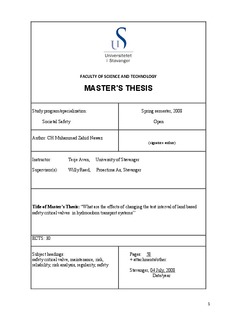What are the effects of changing the test interval of land based safety critical valves in hydrocarbon transport systems
Master thesis
Permanent lenke
http://hdl.handle.net/11250/181903Utgivelsesdato
2008Metadata
Vis full innførselSamlinger
- Studentoppgaver (TN-ISØP) [1428]
Sammendrag
In this master thesis, the effects of changing the test interval of the land based safety
critical valves have been highlighted. Compliance with the regulations given by the
PSAN (Petroleum Safety Authority Norway) requires annual testing of these valves.
The testing of safety critical valves are essential to increase the probability that the
valves are able to conduct intended functions, and beneficial to improve safety and
regularity. Moreover, "Too often" testing can lead to unnecessary production loss, with
major economic consequences, and the danger/risk of test-induced errors. "Too less"
testing can lead to the valves failure, which in a result could have major consequences
in relation to safety and long downtime during repairs.
There are a number of test methods (differential pressure test, partial stroke testing etc.)
used for different safety critical valves, because Valve design, the consequences of
downtime, environmental aspects of the testing, etc. varies between different safety
critical valves. The choice of inappropriate test regimes can lead to unnecessary
downtime and environmental emissions in testing. Thus these different test methods
have great influence on the effects of changing the test interval of the safety critical
valves.
It is not simple and easy to clarify and conclude, which case of changing the test interval
is more appropriate in connection with all the effects related to the change of test
interval of these valves. As there are many factors (degradation mechanism, failure
modes, testing methods, regularity, production effects) which needs to be deeply
analyzed and evaluated for future research.
Beskrivelse
Master's thesis in Risk management and societal safety
